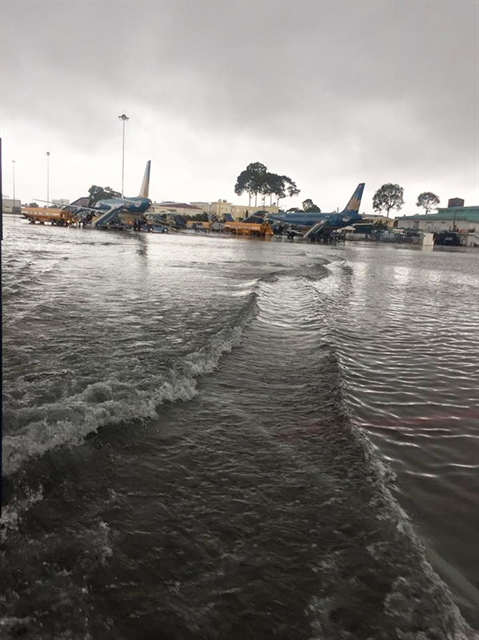 Society
Society


|
| Tân Sơn Nhất international airport in HCM City after a downpour in 2016. VNA/VNS Photo Mạnh Linh |
HCM CITY — The HCM City People’s Council has urged Tân Bình District authorities to speed up the progress of flood-prevention projects inside Tân Sơn Nhất international airport to prepare for the coming rainy season.
Speaking at a meeting with district authorities on Wednesday, Phạm Đức Hải, vice chairman of the city’s People’s Council, said the progress of major anti-flooding projects inside the airport had been too slow and urged authorities to work with agencies to map out detailed plans.
Hải, leader of an inspection team from the People’s Council, recently inspected canals and sewers at and near the airport.
Key drainage systems operated by companies at the airport vary in design and lack connectivity, causing serious flooding in the airport, especially during rainy season, he said.
Hứa Quốc Hưng, vice chairman of Tân Bình District People’s Committee, said at least 10 companies have built different drainage systems which are not connected.
The companies also did not cooperate with local authorities when rehabilitating the drainage systems, he said.
The drainage system inside the airport is incomplete and is not connected to the drainage system outside the airport.
In addition, many local households encroaching on land along the drainage canals have worsened the flooding in the airport area.
Worse still, local residents are still throwing trash into the canals near the airport, greatly contributing to the flooding, Hưng said.
Delayed projects
Major flood-prevention projects, including the upgrade of Hy Vọng, Tân Trụ, A41, and Nhật Bản canals, have been delayed due to tardy site clearance and lack of investment, according to Hưng.
Although the city has approved the projects, they have yet to be implemented.
As planned, the project to upgrade the A41 canal was supposed to be completed last year, but site clearance took too much time.
The project to upgrade Hy Vọng Canal was approved in 2016, but has not been implemented due to a lack of financing. The city is still mobilising investment capital.
According to the city’s Steering Centre of the Urban Flood Control Programme, the drainage system inside the airport needs to be connected properly with the drainage system outside the airport.
The Ministry of Transport has recently approved a project to renovate the internal facilities of the airport, which is expected to improve flood prevention efforts.
In addition, under another plan approved last year by the Ministry of Transport, priority will be given first to building anti-flooding works as part of airport expansion.
Under the plan, which has been submitted by the ministry to the Prime Minister, work on a reservoir with a state-of-the-art pumping system must begin as soon as possible and be completed by the end of this year.
Serious flooding in the landing areas and runways has caused chronic delays at Tân Sơn Nhất airport in recent years, according to the Steering Centre of the Urban Flood Control Programme.
About 40 per cent of all flights in the country depart and arrive at Tân Sơn Nhất airport.
The latest report by the centre found that the drainage system has been blocked by trash both inside and outside the airport.
In the landing area and warehouses, water could not flow out because of narrow sewers.
In 2016, heavy rains flooded parts of the airport, with water rising as high as 20 centimetres, threatening to compromise the airport’s power generators, and prompting employees to barricade the area with sandbags. — VNS